AI copywriting can be transformational for online lead generation and selling.
Effective copywriting can be the difference between a 1% or 10% click-through rate.
It can be the difference between hundreds of sales or thousands.
That’s why it’s important to understand how powerful AI has become for copywriting.
Let’s dive in.
AI has streamlined copywriting’s most repetitive, tedious tasks, letting human writers take a step back to focus on strategy and creativity.
Artificial intelligence copywriting focuses on the short-form content that makes up the majority of copywriting work:
Ad copy, social media copy, e-commerce product descriptions, and landing page copy, among others.
Ad agencies, ecommerce businesses, and social media marketing teams are just a few of the professions evolving their workflows to incorporate AI copywriting.
(This also includes general AI for content marketing, too).
Applying the power of AI to copywriting
AI copywriters are trained on enormous sets of data. GPT-3, the underlying model on which AI copywriting tools are based, has analyzed billions upon billions of lines of text.
AI copywriting tools create copy based on simple inputs, and can handle anything from short ad copy to social media captions to full sales pages.
Today’s AI tools allow you to specify a tone of voice—anything from “witty” to “luxury,” or even “Oprah.”
The implication? You get a consistent brand voice across thousands of ecommerce product descriptions or social media captions, all while increasing your output.
One of the easiest wins for those new to AI copywriting is short form persuasive copy like pay-per-click (PPC) ad copy and product descriptions.
This kind of work requires something human copywriters aren’t great at: volume. PPC ads require multiple ad copy options for A/B optimization, in order to select the best-converting version.
Ecommerce businesses may have hundreds or thousands of products, each of which requires a compelling product description that has a direct impact on sales. AI copy is perfect for both of these applications.
AI for long form copywriting can work too. For example, you might use AI tools to generate a headline for your landing page. You then use that headline to generate an outline for the page.
Finally, you can use the outline to generate individual paragraphs, before having a human copywriter smooth things over.
AI copywriting tools are good for writers
Despite concern from writers that AI tools threaten their jobs, the reality is that these tools perform best when guided by humans.
As a writer, AI copywriting tools give you an edge. Writers who don’t use AI tools write more slowly, often getting stuck at the research or brainstorming phase or succumbing to writer’s block.
Without AI support, writers are comparatively slow to pump out the kind of volume necessary to A/B test ad copy, or to create dozens of options for headlines or email subject lines.
By using AI tools, writers reduce the volume of words they need to produce.
They also eliminate the most repetitive and tedious tasks in copywriting, like writing product descriptions or creating dozens of similar ad copy variations.
With less work and fewer repetitive tasks, writers can focus on higher-value tasks like strategy, editing, and optimizing for conversions.
Use cases for AI copywriting
Let’s take a deeper look at a few use cases for AI copywriting.
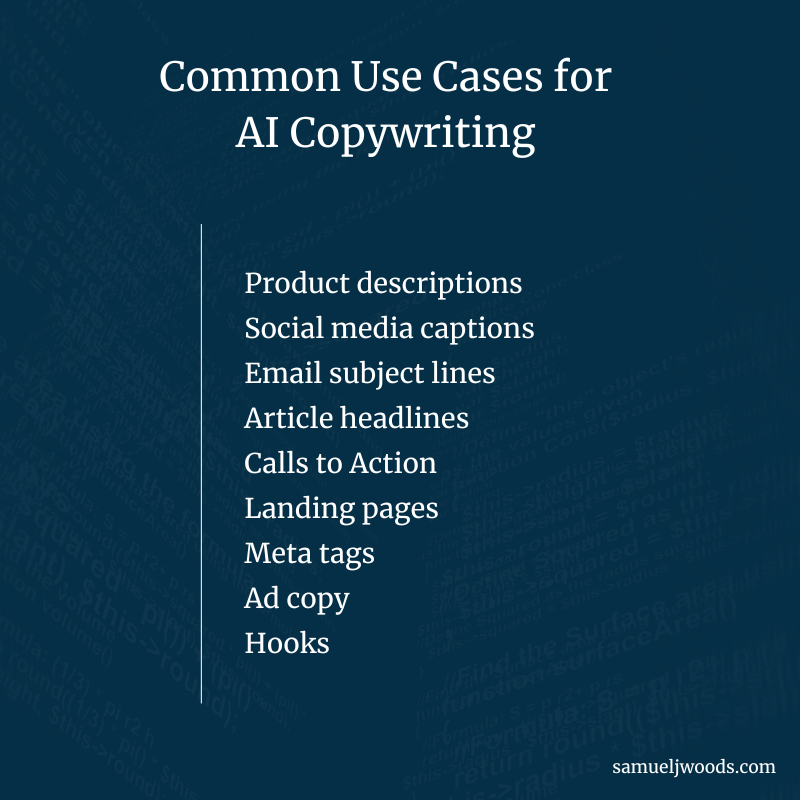
Product descriptions
In the world of ecommerce, you can’t touch or experience products directly. That’s why it’s crucial to have compelling product descriptions.
But writing product descriptions for hundreds or even thousands of SKUs is tedious.
This kind of function can be easily outsourced to AI copywriting tools. By choosing a consistent “tone” for each product description, you can make the brand voice consistent across the site–even as individual human writers come and go.
Ad copy
Ad copy is one of the most common uses for AI copywriting, and with good reason. Paid ad platforms constantly test different versions of the same ad against each other. The more options you can have for compelling ad copy, the better.
AI tools let you generate dozens of options, pick from the best, and then let your ad platform A/B test the different copy to see what performs best.
Creativity and understanding your audience is important here, just as with any other copy. But volume is key too. It’s important to generate a high volume of copy options and let optimization tools display the version of the ad that performs best. This is where AI tools shine.
Social media captions
Social media managers often post multiple times a day across different social platforms. The volume of responsibility takes its toll, and creativity can suffer.
AI copywriting tools help social media managers easily and quickly generate captions that captivate and drive engagement. From there, it’s easy for human copywriters to polish.
Email subject lines
A 2019 study tested four different subject lines on an email reaching 1.4 million people. The study found the highest-performing option led to 10.7% higher open rates than the control. Some surveys indicate that 33% of email recipients open an email based on the subject line.
The best way to improve the effectiveness of an email campaign? Experiment with different subject lines to improve open rates. AI copywriting tools can often do a more effective job of this than human copywriters—especially when multiple options are needed for A/B testing.
Article headlines
Article headlines serve an important dual purpose: they convince people to click on an article, and they convince people to keep reading. An incredible article with a lackluster headline won’t get the attention it deserves.
AI copywriting tools can generate dozens of headline options. From there, you can tweak the headline copy to maximize click-through rates and improve on-page engagement.
Meta tags
Meta tags, including titles and meta descriptions, are necessary but often tedious parts of search engine optimization for human writers.
AI copywriting can improve click-through rates by generating compelling options for title tags and meta descriptions. This has a real impact on the ROI of any given article—search engine models like Google’s RankBrain move websites up and down based on factors like click-through rate.
Calls to Action
Calls to Action (CTAs) are often split-tested to optimize for conversions. AI copywriters can help you test a variety of CTAs to see what your audience responds best to.
Landing pages
AI copywriters can generate all the various components of a landing page: Headline, hook, CTA, product or service benefits, and accompanying sales copy. All that’s left is for you to string them together and add a human touch.
Hooks
Whether on social media or within an article, hooks keep people engaged. Many AI copywriting tools have a setting for generating hooks. Rather than reinvent the wheel, human copywriters increasingly use AI to generate multiple options for engaging hooks.
How to use AI copywriting tools
Working with AI copywriting tools isn’t about typing in a prompt and being done with it.
Instead, AI tools help:
- Generate momentum
- Break through writer’s block
- Create raw materials to fine-tune
AI can do the grunt work—but only if you guide it with the right prompts.
Follow these steps for a better outcome:
1. Choose your AI copywriting type
Choose the right type of copy. AI tools are trained to produce different types of copy depending on the options you select: Ad copy, social media captions, product descriptions, and so on.
In this example, I’ll select “Instagram Captions” via Copy AI, one of the best AI copywriting tools.
2. Give a prompt
Give the AI an initial prompt to work with. It’ll use your input to generate options. The more detail you can give, the better your results will be.
Imagine you’re a social media marketer. You need to come up with a clever caption to describe a photo of a work retreat. But you’re juggling a million things and aren’t feeling creative.
AI is perfect for this situation. You don’t have to try to be clever. Just put in a fact-based description of the photo you’re posting. Later, AI will sort out how to spice it up.
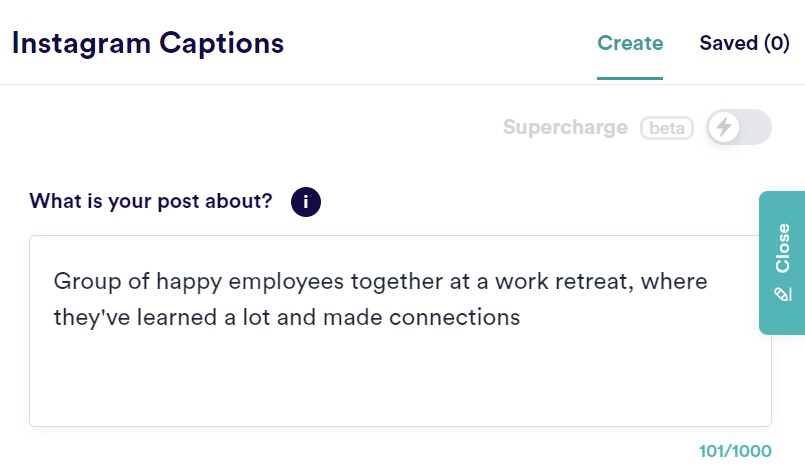
3. Set tone of voice
Tone of voice options provide brand consistency.
Your brand has a tone of voice, and your audience responds to that tone of voice. AI tools can help maintain it so your brand always feels on point—no matter who’s managing your social media.
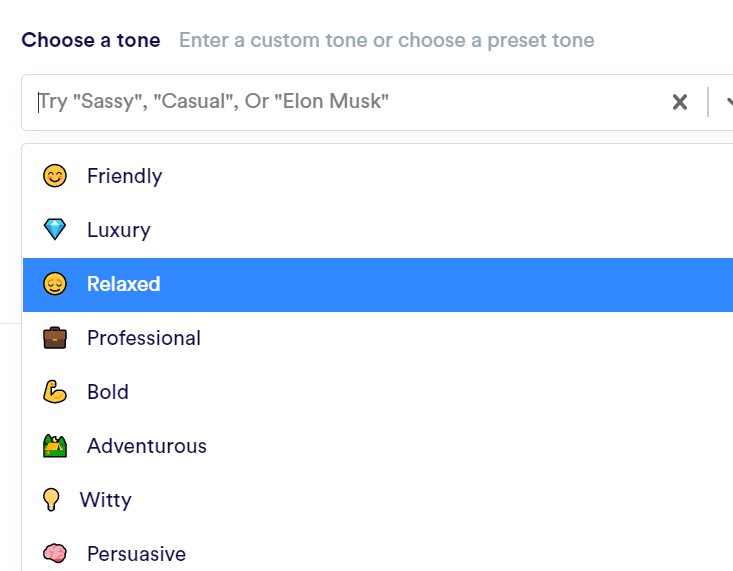
4. Review outputs and guide the AI
With your prompt and the tone of voice selected, the AI will generate options for you.
Some will be pretty good.
These options below are nearly ready for publication after some light editing:
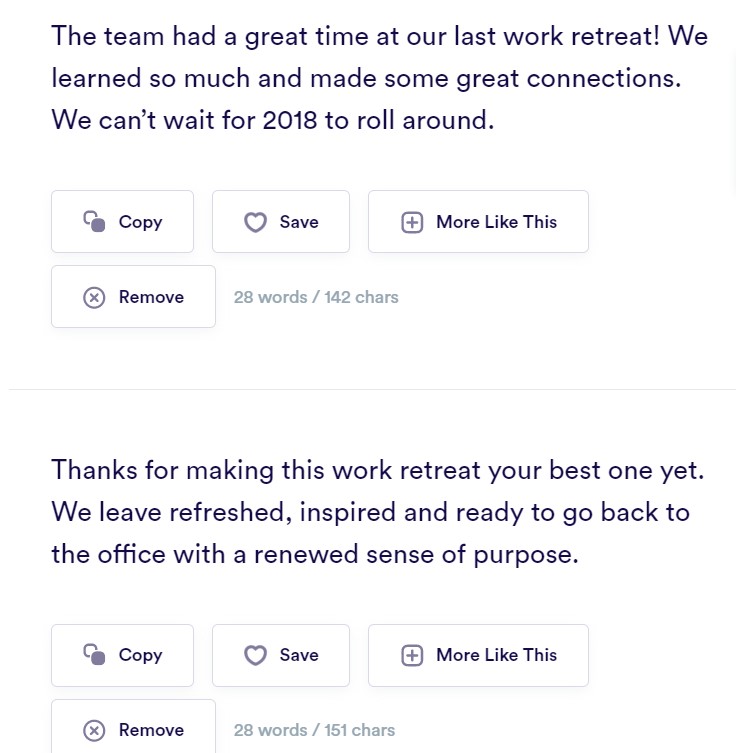
Some of the AI-generated outputs will be weak and uninspired.
For example, these sound particularly “robotic.”
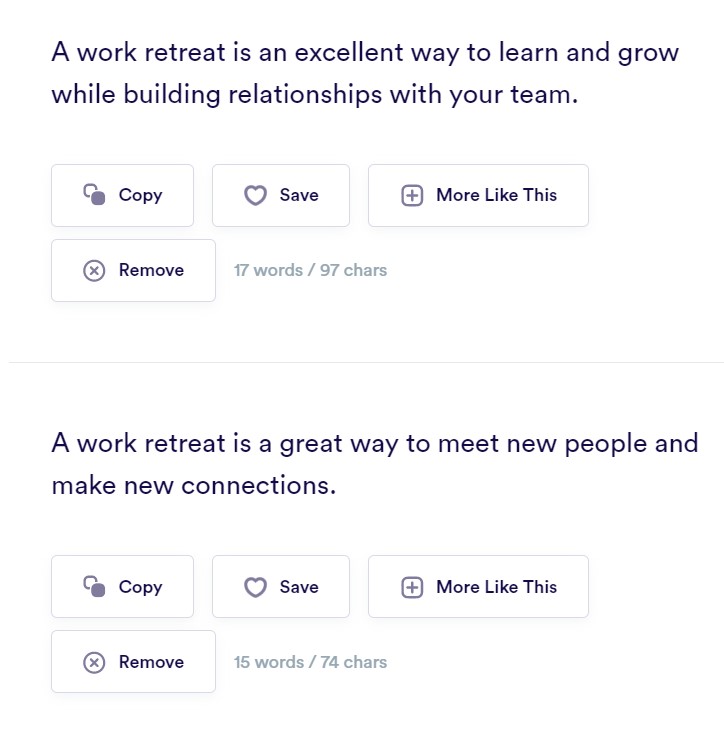
Know that AI outputs will be a mixed bag to start.
You can go back and add more detail to your prompt and run it again. Or, you can select one of the options you like and tell the AI to generate similar versions.
Designing a hybrid human/AI copywriting workflow
Copywriting has enormous implications for marketers, entrepreneurs, and businesses of any size (not just enterprise).
But relying on human writers for each and every copywriting function is a losing battle.
That’s because competitors using AI tools can churn out faster, better content across multiple marketing channels, while avoiding putting their writing team at risk of burnout.
Businesses not using AI might experience:
- Lower click-through rates
- Higher cost-per-click
- Slower publishing speeds
- Worse conversion rates
- Weaker engagement
AI copywriting tools empower writers to be faster, more creative, and more data-driven. By eliminating writing’s most tedious tasks, AI tools allow humans to do what humans do best: focus on strategy and creativity, and let machines do the heavy lifting.
Not every ad agency, ecommerce business, or brand has pulled AI copywriting into their workflow yet.
But those that don’t are putting themselves at risk of being left behind.